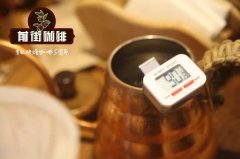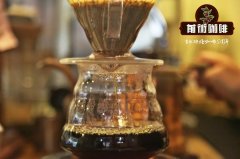Explanation of three-stage water injection | timing of water injection for hand-brewed coffee

Professional coffee knowledge exchange more coffee bean information please follow the coffee workshop (Wechat official account cafe_style)
When is the timing of this water injection, and how to inject water in three stages?
Also, is the steaming time calculated from the beginning of water injection, or is it timed after water injection?
First of all, the editor first explains: the demonstration and suggested parameters of the editor are all timed from the end of the water injection, and then the steaming starts. Generally, it will indicate the amount of water injected for the second time + the time of steaming.
Take our most commonly used 15 grams of powder for example, generally about 30 grams of water is injected, and the steaming time is 25-35 seconds. We still use the commonly used V60 filter cup as a reference, the flow rate of V60 is relatively fast, and the flow of water injection is too large, which will raise the liquid level, and more water will flow down from the ribs on the edge, reducing the process of contact and extraction with coffee powder, and vice versa. Therefore, when using the method of large water flow and fast flushing, the cooking time is shorter, the aroma is more prominent, but the flavor is insufficient, and it is easy to lack of extraction. On the other hand, slow flushing with small water flow to prolong the extraction time can fully extract the flavor of coffee, which can show the characteristics of V60 in terms of richness and layering.
In terms of grinding degree, the thickness of coffee powder can be divided into five grades: coarse powder, medium powder, medium and fine powder, very fine powder.
Shallow baking will use medium and fine powder, suitable for shallow baked beans, today use filter cup: Hario v60 transparent resin, grinding scale: small Fuji ghost teeth 3.5, white granulated sugar size (the most common white granulated sugar in the supermarket, a little larger than that), demonstration [Sakuran] for cooking teaching:
Medium and shallow roasted coffee beans are suitable for extraction at about 90-92 water temperatures, such as Flower Butterfly, Yega, Sidamo, and deep-roasted coffee beans are suitable for temperatures ranging from 86 to 88 degrees, such as Manning.
15 grams of beans, Xiaobian stew water injection volume of 30 grams, the time will be completed in about 3 seconds, that is to say, from the end of water injection time, water injection completed-"stuffy steam 30 seconds; if the time starts from the beginning of water injection, then water injection 3 seconds + steaming 30 seconds = 33 seconds
First water injection
A small water column is injected from the center, and then slowly wound out, just like gently laying a layer of water on the noodle, although it is a small water column, please be careful not to slow down the circle speed, because once the circle speed is too slow, the water column will flow in a single direction, so that the draught of the powder layer is uneven.
After the end of the first water supply, the coffee powder particles will push each other due to exhaust, resulting in expansion. When the expansion reaches the highest point or is about to rest (the surface water will slowly dry), it is the time to add water for the second time.
Second water injection
The second water injection also starts from the middle, injecting a small water column into the bottom of the powder layer, and paying attention to the amount of water at the beginning of the second water supply, not exceeding the height of the powder layer as far as possible, that is to say, when the water column is wound close to the filter paper, the water supply can be stopped.
In the initial stage of water supply, because most of the coffee powder particles are in a state of exuberant exhaust, the air produced by them will soon be transmitted to the edge of the filter paper, so if you give too much water at this time, instead of bringing the water to the bottom, you should use a small water column to speed up the circle to avoid these problems.
As the thicker powder layer on the edge of the original filter paper becomes heavier because of the draft, and as the water level falls and becomes thinner, the water level drops to half and the third water injection can be carried out.
How to judge water injection by the speed of water level falling?
At the time when the water is added again, it should be judged according to the state of decline.
When the water supply reaches the bottom, the particles at the bottom begin to expand, and as the water at the bottom runs out, the whole powder layer decreases.
When the coffee powder particles do not absorb much water at first, because the coffee powder particles are lighter, most of the coffee powder will float on the water surface, and as the water level drops, the surface will look like a bowl or a U-shaped with a large opening.
The speed at which the water level drops represents the amount of draught of coffee powder particles. Because the coffee powder in the filter cup is lighter than water at first, the coffee powder particles will sink more slowly than the water flow, and when the coffee powder eats more water and the weight becomes heavier, the coffee powder particles will quickly reach the bottom of the filter cup and cause blockage, thus delaying or even stagnating the decline of the water level.
When the water level falls too fast, there is no need to add water. Because when the current falls faster than the particles, it means that the water is scouring the coffee powder particles, so that the coffee powder particles are not in a static state.
When the water level drops slowly, it means that coffee powder particles begin to deposit at the bottom, causing blockage and causing the water level to fall slowly.
When the water level stops falling, it means that the bottom is completely blocked, and the coffee powder particles are also soaked in the water, and once this situation continues for too long, the bitter taste will follow.
Therefore, at the time point of adding water, when the water level is delayed or when the water level no longer falls, it is the time to start the third time to add water.
The third water injection
From the third water supply, it is necessary to observe the extent of the decline of the water level, also from the center of the water supply circle, the amount of water should not exceed the height of the powder layer, then it will also be observed that the proportion of foam has already occupied the surface, and the third water injection will increase the tumbling of coffee granules, let all the deposited particles tumble, and then dissolve the soluble matter.
The rolling particles will start to rest because they stop adding water, and at this time they have to rely on the velocity caused by the falling water level to make the coffee particles produce friction, so once the addition of water stops, the coffee powder particles will sink, causing blockage, so pay special attention to the rhythm of adding water.
If the water is cut off too many times, it is tantamount to letting the coffee powder particles soak in the water all the time, which will lead to the astringent and miscellaneous taste of the coffee extract at the end.
When close to the set amount (15g powder, 225g water, powder-water ratio 1:15), the filter cup can be removed.
Related recommendation: is hand-made coffee really good? Why does coffee smell better than it tastes?
Important Notice :
前街咖啡 FrontStreet Coffee has moved to new addredd:
FrontStreet Coffee Address: 315,Donghua East Road,GuangZhou
Tel:020 38364473
- Prev

What is the water temperature of hand-brewed coffee? Water temperature of hand-brewing coffee skills
Professional coffee knowledge exchange more information about coffee beans Please follow how does the water temperature in the coffee workshop (Wechat official account cafe_style) affect your coffee? In the brewing process, water and coffee will undergo some complex chemical reactions, and the water temperature will directly affect the extraction rate of different components in the coffee during brewing. Water will extract quinic acid, amino acids and tannins from coffee.
- Next

The right way to make coffee by hand: the three principles that beginners need to know
Professional coffee knowledge exchange more coffee bean information Please pay attention to the coffee workshop (Wechat official account cafe_style) the fun and charm of hand brewing coffee is that you can use a convenient and easy way to make coffee, in fact, the editor does not understand from the very beginning, but also through reading, learning, brewing experiments, based on their own experience summed up some commonly used hand brewing skills. Push today
Related
- Beginners will see the "Coffee pull flower" guide!
- What is the difference between ice blog purified milk and ordinary milk coffee?
- Why is the Philippines the largest producer of crops in Liberia?
- For coffee extraction, should the fine powder be retained?
- How does extracted espresso fill pressed powder? How much strength does it take to press the powder?
- How to make jasmine cold extract coffee? Is the jasmine + latte good?
- Will this little toy really make the coffee taste better? How does Lily Drip affect coffee extraction?
- Will the action of slapping the filter cup also affect coffee extraction?
- What's the difference between powder-to-water ratio and powder-to-liquid ratio?
- What is the Ethiopian local species? What does it have to do with Heirloom native species?

